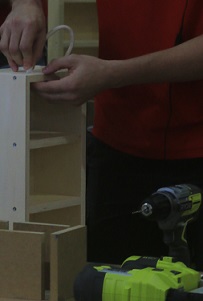Learn Building Renovation
 Knowing how to repair buildings is a handy skill for anyone; and a valuable foundation for developing a business or career in the construction industry.
Knowing how to repair buildings is a handy skill for anyone; and a valuable foundation for developing a business or career in the construction industry.
This course may help a handyman or builders labourer to move their work opportunities to a higher level; or form a foundation for you to improve and increase the value of the home you live in
Course Structure
This course is split into the following ten lessons:
- Introduction to Building Renovation Projects
- Core Structural and Site Works.
- Replacing/Repairing Roofs and Floors
- Doors, Windows and Walls
- Plastering
- Carpentry Renovation
- Painting
- Plumbing Basics
- Electrical Basics
- Renovating a Room
Course Duration - 100 hours
What will You Learn?
This course will expand your knowledge in how to repair or replace every common part of a building, from roofs and floors to doors, windows and walls.
Walls alone may come in a wide range of types and sizes, from plaster to brick, timber or other materials.
Exposed bricks or stones on internal walls have become a fairly common feature in home renovations, particularly industrial type buildings like converted warehouses and barns. The quality of brick face, however, is often not high quality enough standard for many people's tastes. Usually only the best face bricks are used on the exterior walls; because interior bricks are expected to be plastered, they are often of lower quality.
In wet areas such as kitchens and bathrooms, tiles are commonly used to make walls waterproof and provide an attractive finish. Both plastering and tiling have specialty tradespeople, but there are some things which home renovators can comfortably tackle themselves.
In older properties the walls are most likely to have lath and plaster. In modern houses and those which have had old plaster replaced or new partitions added, plasterboard is more common.
Using Plaster
Plaster provides a smooth finish to a surface and should be durable. Plaster should be able to be painted. Plaster is also usually more hygienic than exposed brick or block work, and it provides insulation against extremes of temperature and loud noises, as well as a degree of fire protection.
There are many different types of plaster; each is suited to different types of wall surfaces. The choice of plaster is usually dictated by the finish required and how long can be left before it is decorated. Different types include lime plasters, gypsum plasters, cement-lime-sand plasters, single coat finishes and thin-wall finishes.
Traditional plastering is a three-coat system.
Coat 1 – the first coat, known as a levelling coat (or scratch coat). This is a coarse coat applied directly to laths on the wall. Laths used to be wooden, but are now usually metal, as metal laths don't absorb water like wooden ones (and therefore do not expand or contract with weather shifts). This coat used to be made of lime with sand, fibre and water. Nowadays, it is gypsum with sand and water. The coat should be about 10mm thick. The surface is left scratched or scored with a comb so that the next coat keys into it.
Coat 2 – after the first coat has dried (overnight is usually enough) a second undercoat is applied using the same mix, and to about the same thickness. Unlike the first coat, this coat is not scored but is left smooth instead. Any gaps or holes must be filled and smoothed out. The sand in the mix will provide sufficient texture for the top coat to key into.
Coat 3 – the finishing coat is applied with a float, or steel trowel, when the second coat has dried. This is usually about 48 hours later. Traditional lime plaster is rarely used for finishing these days because it is slow to harden, shrinks as it dries, is not very strong and tends to mark easily. A mix of cement, lime and sand gives better results. The coat is applied thinly using a sweeping arching motion of the float and by not removing the float from the wall's surface. The plaster is sprayed with water to keep it moist as it is worked on the wall.
Where the quality of finish is unimportant e.g. the walls of a shed or outhouse, just one or two layers of rough plaster might be applied. On some surfaces just one or two layers may be all that is needed for a smooth finish. It depends on the suction and evenness of the material which is being plastered. For instance, plasterboard and smooth concrete only need one coat.
Plaster can also be applied to various types of board such as gypsum baseboards, insulating boards and wallboards.
You learn more about all these things throughout this course; not only through reading about it; but also working through various set tasks and interacting with your expert tutors.